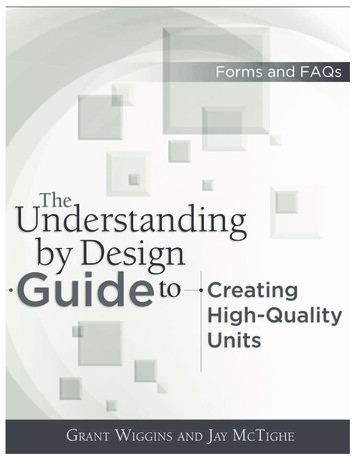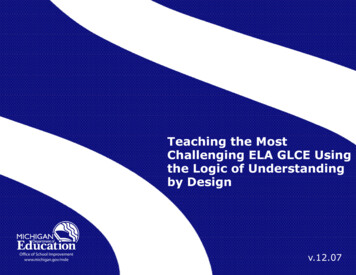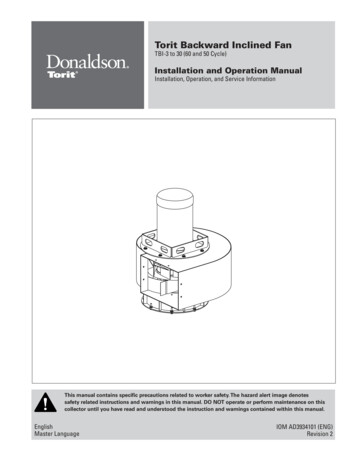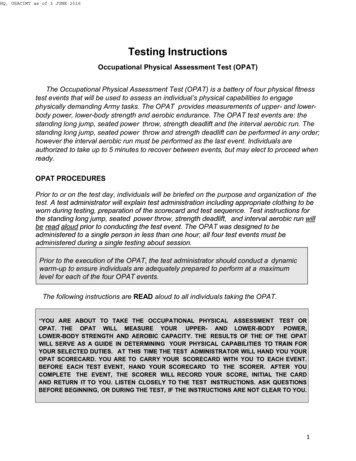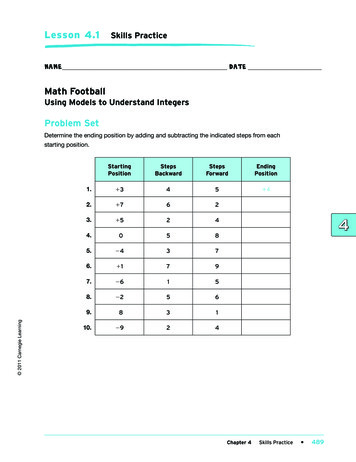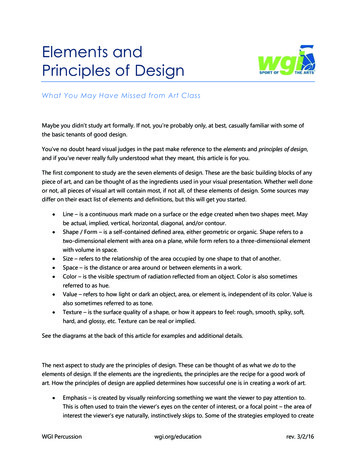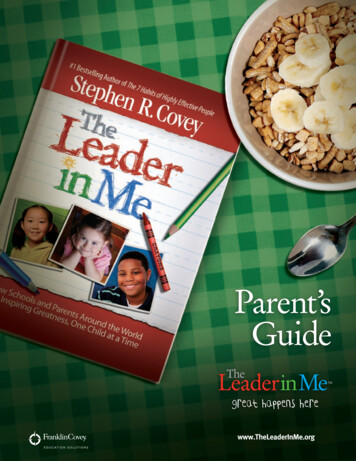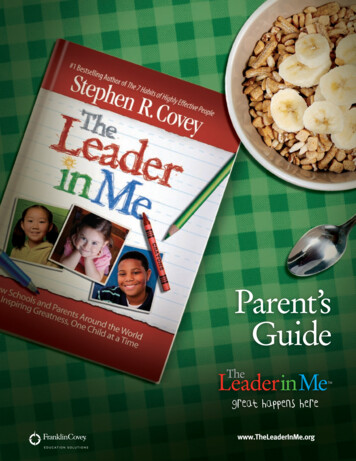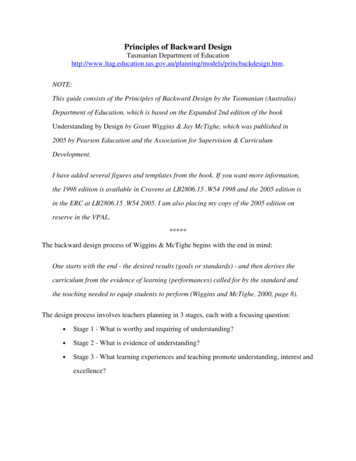
Transcription
Principles of Backward DesignTasmanian Department of ning/models/princbackdesign.htm.NOTE:This guide consists of the Principles of Backward Design by the Tasmanian (Australia)Department of Education, which is based on the Expanded 2nd edition of the bookUnderstanding by Design by Grant Wiggins & Jay McTighe, which was published in2005 by Pearson Education and the Association for Supervision & CurriculumDevelopment.I have added several figures and templates from the book. If you want more information,the 1998 edition is available in Cravens at LB2806.15 .W54 1998 and the 2005 edition isin the ERC at LB2806.15 .W54 2005. I am also placing my copy of the 2005 edition onreserve in the VPAL.*****The backward design process of Wiggins & McTighe begins with the end in mind:One starts with the end - the desired results (goals or standards) - and then derives thecurriculum from the evidence of learning (performances) called for by the standard andthe teaching needed to equip students to perform (Wiggins and McTighe, 2000, page 8).The design process involves teachers planning in 3 stages, each with a focusing question: Stage 1 - What is worthy and requiring of understanding? Stage 2 - What is evidence of understanding? Stage 3 - What learning experiences and teaching promote understanding, interest andexcellence?
2Figure 1.2, 1-Page Template with Design Questions for Teachers, p. 22.Stage 1 — Desired ResultsEstablished Goals: What relevant goals (e.g., content standards, course or program objectives, learning outcomes) will this designaddress?Understandings:Q Essential Questions:Students will understand that . . . What provocative questions will foster inquiry, What are the big ideas?understanding, and transfer of learning? What specific understandings about them aredesired? What misunderstandings are predictable?Students will know. . .A Students will be able to . . . What key knowledge and skills will studentsacquire as a result of this unit? What should they eventually be able to do as aresult of such knowledge and skills?Stage 2 — Assessment EvidencePerformance Tasks:Other Evidence: Through what authentic performance tasks will Through what other evidence (e.g., quizzes, tests,students demonstrate the desired understandings?academic prompts, observations, homework, journals) will students demonstrate achievement of By what criteria will performances ofthe desired results?understanding be judged? How will students reflect upon and self-assesstheir learning?Stage 3 — Learning PlanLearning Activities:What learning experiences and instruction will enable students to achieve the desired results? How will thedesign:W Help the students know Where the unit is going and What is expected? Help the teacher know Where thestudents are coming from (prior knowledge, interests)?H Hook all students and Hold their interest?E Equip students, help them Experience the key ideas and Explore the issues?R Provide opportunities to Rethink and Revise their understandings and work?E Allow students to Evaluate their work and its implication's?T Be Tailored (personalized) to the different needs, interests, and abilities of learners?0 Be Organized to maximize initial and sustained engagement as well as effective learning?Stage 1Using the principles of backward design, teachers focus first on learning goals (understanding goals).These are the enduring understandings that they want their students to have developed at thecompletion of the learning sequence. There is also a focus on a number of essential, or guiding,questions. Enduring understandings go beyond facts and skills to focus on larger concepts, principlesor processes.
3Based on Figure 3.1, Key Design Elements with Prompts, p. 57.Stage 1Identify Desired ResultsEstablished Goals: Identify one or more goals (e.g., content standards, course or program objectives, andlearning outcomes) that the design targets.What understandings are desired? Students will understand that . . . Identify the Enduring Understandings, based on the transferable big Ideas that give thecontent meaning and connect the facts and skills.What essential questions will be considered? Frame the Essential Questions to guide student inquiry and focus Instruction foruncovering the Important ideas of the content.What key knowledge and skills will students acquire as a result of this unit? Students will know. Studentswill be able to . . . Identify the key Knowledge and Skills we want students to know and be able to do. Thetargeted knowledge and skills can be of three different kinds:(1) They can refer to the building blocks for the desired understandings;(2) They can refer to the knowledge and skills stated or implied in the goals; and(3) They can refer to the "enabling" knowledge and skills needed to perform thecomplex assessment tasks Identified In Stage 2.Examples of enduring understandings and essential or guiding questions include: What do we mean by “all men are created equal”? What does it mean to live a healthy life? What does it mean to be independent? Systems are interdependent Living things changeDesign tip for big ideas (p. 77)In skill-focused courses of study, look for big ideas in The value of the skill—what the skill helps you do more effectively or efficiently Underlying concepts (e.g., “persuasion” when teaching the skills of persuasive writing or debate) Issues of strategy—effective techniques, including when to use a particular skill Why the skill works—the theories underlying the skill, so that greater transfer can happen
4Figure 1.4, UbD Design Standards, p. 28.Stage 1—To what extent does the design focus on the big ideas of targeted content?Consider: Are . . . The targeted understandings enduring, based on transferable, big Ideas at the heart of thediscipline and in need of uncoverage? The targeted understandings framed by questions that spark meaningful connections, provokegenuine inquiry and deep thought, and encourage transfer? The essential questions provocative, arguable, and likely to generate inquiry around the centralideas (rather than a "pat" answer)? Appropriate goals (e.g., content standards, benchmarks, curriculum objectives) identified? Valid and unit-relevant knowledge and skills identified?[NOTE: There is a difference between overarching questions and topical questions. Essentialand guiding questions are broad and overarching. They challenge students to think criticallyabout the broader content. Although topical questions are important, this is not what they meanat this point — Bryan]Figure 5.2, An Essential Question Chart, p. 116.IntentOpen: To challenge students tothink more deeply andcreatively about importantrecurring and unsettledissues. Teachers pose thesearguable questions as ameans of engagingstudents in thinking likeexperts in the field. Nodefinitive answer isexpected.Guiding: To guide student inquirytoward a deeperunderstanding of a big idea,teachers pose thesequestions as a means ofuncovering desiredunderstandings. Students constructmeaning as they wrestlewith the question.Scope of the QuestionOverarchingThese are broad and deep questionsthat remain open and alive in thediscipline—perhaps forever. They cutacross unit, course, and sometimessubject boundaries. To what extent is U.S. history ahistory of progress? What is"progress"? To what extent is DNA destiny? Who is a true friend?TopicalThese questions stimulateinquiry and deepenunderstanding of importantideas within the unit. It is notexpected that they will beanswered by unit's end. How might Congress havebetter protected minorityrights in the 1950s and1960s? Should we require DNAsamples from everyconvicted criminal? Should Frog have lied toToad?These are general questions that cut These are unit-specific questionsacross unit, course, and subjectthat converge toward one or aboundaries but that yield one orfew settled understandings ofmore desired understandings.important ideas. How much progress in civil What were the definingrights has the United Statesmoments of the civil rightsmade since the founding of themovement?country? How is reliability ensured in How do recent developments inDNA testing?genetics affect the In what ways was Frognature/nurture argument?acting like a friend in the What are the signs of a "fairstory?weather" friend?
5Wiggins and McTighe suggest the following 'filters' for arriving at worthwhile understandings: represent a big idea having enduring value beyond the classroom reside at the heart of the discipline (involve 'doing' the subject) require uncoverage (of abstract or often misunderstood ideas)offer potential for engaging students.The understandings selected may be overarching understandings (those broad understandings that wemay hope to achieve by the end of the year or over a few years, to which the sequence is contributing),or sequence / unit understandings (those we hope to achieve through the learning sequence). Both arerequired in planning.Stage 2Teachers then decide how their students will demonstrate their understanding. Wiggins and McTighedescribe ‘six facets of understanding’. They believe that students truly understand when they: Can explain Can interpretCan applyHave perspectiveCan empathize Have self-knowledge Chapter 4 of Understanding by Design provides a clear definition of each facet, accompanied by aclear example in the form of a quote from another source, related questions, two valid examples andone invalid example. The six facets make a considerable contribution to understanding the nature ofunderstanding and the various ways in which we may show, or come to, an understanding. Just as withlearning styles, students favor some facts, or are stronger in some facets than they are in others. Thechallenge for teachers is to develop each of the facets in all students. These six facets are continuallyemphasized at each stage of the design process and in particular the second step - determiningacceptable evidence.Figure 8.2, Facet-Related Criteria, p. 177. Facet dictiveFacet 2Interpretation meaningful insightful significant illustrative illuminating Facet ul Facet usual Facet et 6Self-knowledge self-aware metacognitive selfadjusting reflective
6This part of the planning process is what makes 'backward design' quite different from moreconventional planning processes. Before planning learning experiences to develop understandings,teachers are required to plan a range of assessments. Whilst the emphasis is clearly on developingperformance tasks, Wiggins and McTighe advocate a balanced use of assessment, including moretraditional forms such as observation, quizzes, tests etc.The range of assessment tasks and performances selected must: support students in developing understanding give students opportunities to demonstrate that understanding.The tasks must also identify and differentiate levels or degrees of understanding.An important emphasis is that assessment is part of the learning process and should occur throughoutthe sequence, not just at the end.Based on Figure 3.1, Key Design Elements with Prompts, p. 57.Stage 2—To what extent do the assessments providefair, valid, reliable, and sufficient measures of the desired results?Consider: Are . . . Students asked to exhibit their understanding through authentic performance tasks? Appropriate criterion-based scoring tools used to evaluate student products and performances? Various appropriate assessment formats used to provide additional evidence of learning? The assessments used as feedback for students and teachers, as well as for evaluation? Students encouraged to self-assess?Stage 3In the third stage of the backward design process, teachers design the sequence of learning experiencesthat students will undertake to develop understanding.Beyond learning about a subject, students will need lessons that enable them toexperience directly the inquiries, arguments, applications, and points of viewunderneath the facts and opinions they learn if they are to understand them. (Wigginsand McTighe, p 99).The learning experiences require the students to:[T]heorize, interpret, use, or see in perspective what they are asked to learn (or) they will not likelyunderstand it or grasp that their job is more than recall. (Wiggins and McTighe, p 100).Experiences must blend depth and breadth, and may require choices and compromises. Thoseexperiences that are undertaken for depth might require students to unearth, analyze, question, proveand generalize. Those giving breadth require students to make connections, to picture (represent ormodel) and to extend (go beyond).The emphasis is clearly on an inquiry-based approach that requires 'uncovering' the chosen content.
7Based on Figure 3.1, Key Design Elements with Prompts, p. 57.Stage 3To what extent is the learning plan effective and engaging?Consider: Will the students . . . Know where they're going (the learning goals), why the material is important (reason for learning thecontent), and what is required of them (unit goal, performance requirements, and evaluative criteria)? Be hooked — engaged in digging into the big ideas (e.g., through inquiry, research, problem solving, andexperimentation)? Have adequate opportunities to explore and experience big ideas and receive instruction to equip them forthe required performances? Have sufficient opportunities to rethink, rehearse, revise, and refine their work based upon timelyfeedback? Have an opportunity to evaluate their work, reflect on their learning, and set goals?Consider: Is the learning plan . . . Tailored and flexible to address the interests and learning styles of all students? Organized and sequenced to maximize engagement and effectiveness?Overall DesignTo what extent is the entire unit coherent, with the elements of all three stages aligned?Review and refineLike all planning models, backward design requires revision and refinements throughout the planningprocess.Creating a unit using the backward design planning process is not a neat, tidy or easy process. It is arecursive one; you will move back and forth across the curriculum map, making revisions andrefinements each time you add something to a section of your planning. -12/BackwardDesign/BDstep5.htm).Backward design and the Essential LearningsThis is a useful framework to employ when using the backward design model. This framework linksthe three stages of the model with Essential Learnings Frameworks and with other useful documents.Backward Design Planning ning/models/design questions.htm
8Figure 9.4, Question Exploration Guide, p. 212.What is the Critical Question? How does the destruction of the rain/forest contribute to the greenhouse effect?What are the key terms and explanations?Rain forest A thick evergreen forest, in a hot, wet areaGreenhouse A glass house that traps heat for growing plants easilyGreenhouse effect An event in which C02 in the atmosphere absorbs and holds the earth's heat instead of allowing it to leaveWhat are the Supporting Questions and answers?What is happening to the forests? They are being burned so that farmers have more land to growcrops.What does the burning cause? 1. The burning releases more C02 into the atmosphere, and 2. The C02 that the forest once removed stays in the atmosphere. What is the effect of the increase in C02? 1. Increased C02 traps heat in the atmosphere, creating agreenhouse effect; this means that: 2. The earth is becoming warmer.What is the Main Idea?When rain forests are burned, the resulting increase of CO contributes to the greenhouse effect.How can we use the Main Idea?How would cutting rather than burning the rain forests affect the atmosphere?Is there an Overall Idea? A real-world use?Overall idea: What happens in one part of the world can affect us all.Real-world use: Any event that happened in one part of the world affecting others.
9Figure 5.3, Question Starters Based on the Six Facets of Understanding, p. 120.Who? What? WhenWhat is the key concept/idea inWhat are examples ofWhat are the characteristics/parts ofHow might we prove/'confirm/justifyHow isconnected toWhat might happen ifWhat are common misconceptions aboutExplanation? How? Why? Why is this so?InterpretationWhat is the meaning ofWhat doesHow islikeHow does?reveal about?(analogy/metaphor)?relate to me/us? So what? Why does it matter?Application?How and when can we use this (knowledge/process)How isapplied in the larger world?How could we useto overcome(obstacle, constraint, challenge)?PerspectiveWhat are different points of view aboutHow might this look from's perspective?How issimilar to/different fromWhat are other possible reactions toWhat are the strengths and weaknesses ofWhat are the limits ofWhat is the evidence for? Is the evidence reliable? Sufficient?EmpathyWhat would it be like to walk in's shoes?How mightfeel about?How might we reach an understanding about?What wastrying to make us feel/see?Self-KnowledgeHow do I knowWhat are the limits of my knowledge aboutWhat are my "blind spots" aboutHow can I best showHow are my views aboutshaped byWhat are my strengths and weaknesses in?(experiences, assumptions, habits, prejudices, style)?
10
11ReferencesGood references for backward design include:Grant Wiggins and Jay McTighe. Understanding by Design. Expanded 2nd Edition. (Upper SaddleRiver, NJ/Alexandria, VA: Pearson Education/Association for Supervision & CurriculumDevelopment, 2005).Overview of backward design and (FAQ) Frequently Asked Questions (this site also has a number ofother very useful pages about the process). ckwardDesign/Overview.htm [Accessed 31st August, 2004].A PowerPoint on Understanding by Design, developed from Wiggins and McTighe’s book aboutBackward Design, which is a very good introduction and explanation of the key points of theprocess tanding by Design TeachingEllen Meier CTSC.pdf [Accessed 31st August, 2004].A helpful description of the backward design process and a template for process.html [Accessed 31st August, 2004].Ravenswood Heights [a school system in Tasmania] used backward design and have somerecommendations for others ravenswd.htm[Accessed 31st August, 2004].This page has been produced by the School Education Division [Government of Tasmania]. Its content has been authorizedby the Executive Director (Curriculum Standards and Support). Questions concerning its content may be directed by emailto ltag@education.tas.gov.au. This page was last modified on Friday, 05 November 2004.The URL for this page is ls/princbackdesign.htm.You are directed to a disclaimer and copyright notice governing the information provided.[Note: I am using this guide under the terms of the Tasmanian copyright notice. I am also using the figures fromUnderstanding by Design under the Fair Use provisions of the U.S. Copyright Act. So my distributing this within the libraryis legal. — Bryan]
The backward design process of Wiggins & McTighe begins with the end in mind: One starts with the end - the desired results (goals or standards) - and then derives the curriculum from the evidence of learning (performances) called for by the standard and the teaching needed to equip students to perf
